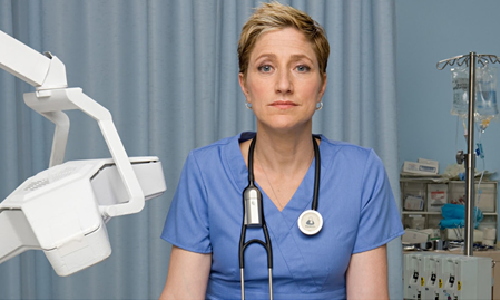It is always a good time to promote better hospital communication, and mechanisms should be in place to ensure it. But it doesn’t happen. Picture this worst-case scenario:
After surgery, a doctor uses unfamiliar terminology in an unfamiliar accent to describe what to do next while looking at an electronic medical record. The doctor’s voice competes with noisy machines and other nearby conversations. The patient doesn’t understand most of the conversation but also doesn’t seek clarification because it’s clear everyone is in a hurry and due to the intimidating power differential of the white coat. If the patient recognises hearing loss and if he or she had a device to help, it was intentionally left at home so it wouldn’t be lost during the procedure.
Perhaps this is just a cartoon of a comically bad interaction, but surely some elements of this scenario may commonly ring true.
Now Add COVID-19.
All faces are covered. Interpreters are on screens. Visitors and significant others who help understand and remember things must stay home. People are stressed. Care is sometimes remote, too, which brings in the competing sounds and distractions of home.
If then wasn’t the time to address the problem of communication for people with hearing loss in a medical setting, now is.
Of course, people who work in hospitals and clinics don’t want to communicate poorly. Quite the contrary! Rather, they are pushed to remember a myriad of both timeless and topical themes.
As an “invisible” condition, hospital personnel can’t see your communication needs coming. They can’t exercise their empathy and understanding for something they can’t see. Even in Audiology departments and now at an ear specialty-care hospital, we strive to reach (and sometimes fall short) of our communication goals.
The good news is that there are things that we all (hospital administrators, providers, and patients with hearing loss) can do. Many steps can be taken.
Hospitals can:
- Provide paper or links to communication cards that provide visual cues to commonly asked questions and appropriate replies.
- Provide links for patients to download automated captioning apps (often free) that transcribe and keep a record of conversations.
- Provide inexpensive personal sound amplifiers for patients who could use them.
- Ensure medical record systems highlight hearing loss and allow patients to identify needs so that accommodations can be provided reflexively.
- Integrate remote professional CART into remote care sessions. This is easily done across all remote care platforms such as Zoom, Microsoft Teams, Skype, etc. If professional CART is unavailable, then automated captioning is available.
- And especially during COVID, at the entrance to the hospital, greet patients with a clear face mask.
Patients who find benefit from speechreading can be informed that clear masks can be made available in their clinical visits. Providers can:
- Presume patient populations likely to have hearing loss indeed do, rather than assume normal hearing.
- Use clear face masks (Ed: FDA approved) when their patients rely on lipreading.
- Encourage patients with hearing devices to use them during clinical conversation to enhance communication needed to improve health care outcomes.
- Insist Communication Access Realtime Translation (CART) or Sign Language interpreters are available, as appropriate.
- Establish routines for using low-technology communication strategies including facing patient when talking to them, using a slow rate of speech, limiting background noises during conversations, and ensuring patient’s attention before conversation.
- Provide paper handouts written in accessible language with instructions relevant to treatment.
The Hearing Loss Association of America Health Care Task Force will be exploring ways to turn these critical practices into actions.
About the author: Kevin H. Franck Ph.D. is the senior vice president for Marketing Strategy and New Product Planning at Frequency Therapeutics in Woburn, MA. He is the Vice Chair of the Board of Directors of the Hearing Loss Association of America.
Deafness Forum thanks the Hearing Loss Association of America for permission to republish this article which appeared in Hearing Life Magazine (Winter 2021).

